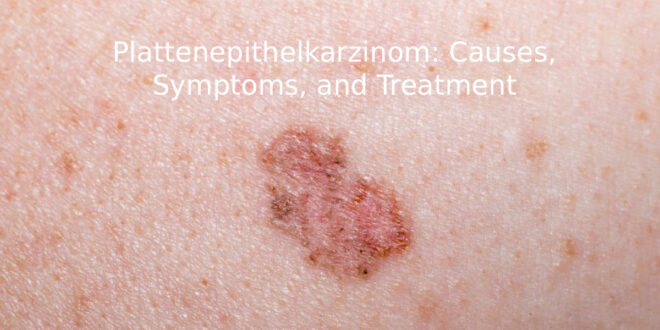Among the various forms of cancer that affect humans, Plattenepithelkarzinom—commonly known as squamous cell carcinoma (SCC)—is one of the most frequently diagnosed types. This malignancy originates from the squamous epithelial cells, which make up the outer layer of the skin as well as the linings of the mouth, throat, lungs, and other organs.
While often curable when detected early, Plattenepithelkarzinom can become aggressive and life-threatening if left untreated. Its incidence has been rising globally due to increased exposure to ultraviolet (UV) radiation, tobacco use, and environmental carcinogens.
This comprehensive guide explores everything you need to know about Plattenepithelkarzinom, including its causes, symptoms, diagnostic methods, treatment options, and preventive strategies. We will also include practical tables summarizing essential details for quick reference.
What Is Plattenepithelkarzinom?
The term Plattenepithelkarzinom comes from German, where:
- “Plattenepithel” means squamous epithelium, referring to the thin, flat cells that line many parts of the body.
- “Karzinom” means carcinoma, a type of cancer that originates in epithelial cells.
Thus, Plattenepithelkarzinom literally means “squamous cell carcinoma”, a malignant tumor arising from squamous cells.
This cancer can occur in various parts of the body, including:
- Skin (cutaneous squamous cell carcinoma)
- Mouth and throat
- Lungs
- Esophagus
- Cervix
- Anus
- Bladder
Each type behaves differently, depending on where it starts and how early it’s diagnosed.
Types of Plattenepithelkarzinom
Although the basic cell type is the same, Plattenepithelkarzinom manifests differently depending on the organ involved. Below is a summary of the main types:
| Type | Common Location | Main Causes | Prognosis |
|---|---|---|---|
| Cutaneous SCC | Skin | UV radiation, tanning beds | Excellent if detected early |
| Oral SCC | Mouth, tongue | Tobacco, alcohol, HPV | Moderate to poor |
| Esophageal SCC | Esophagus | Smoking, alcohol, poor diet | Poor if diagnosed late |
| Lung SCC | Lungs | Smoking, air pollution | Variable depending on stage |
| Cervical SCC | Cervix | HPV infection | Good with early treatment |
| Anal SCC | Anal canal | HPV infection | Fair with therapy |
| Bladder SCC | Urinary bladder | Chronic infection, smoking | Variable |
How Does Plattenepithelkarzinom Develop?
To understand how Plattenepithelkarzinom arises, it’s important to know what happens inside the cells.
Squamous cells are designed to protect tissues underneath them. However, when these cells are repeatedly damaged—by UV light, chemicals, or infections—the DNA inside them begins to mutate. Over time, these mutations disrupt normal cell growth and division, leading to uncontrolled proliferation.
Eventually, the mutated cells form a tumor, which may invade nearby tissues and metastasize (spread) to other organs through the bloodstream or lymphatic system.
Causes and Risk Factors of Plattenepithelkarzinom
There isn’t one single cause for Plattenepithelkarzinom. Instead, multiple risk factors contribute to its development.
1. Ultraviolet (UV) Radiation
Prolonged exposure to the sun or artificial UV sources (like tanning beds) is the leading cause of cutaneous Plattenepithelkarzinom. UV rays damage cellular DNA, causing mutations that lead to cancer.
2. Tobacco Use
Cigarette smoking and chewing tobacco increase the risk of oral, lung, and esophageal squamous cell carcinoma. Tobacco chemicals directly attack the epithelial lining, promoting mutation.
3. Alcohol Consumption
Excessive alcohol irritates the mucous membranes and increases the likelihood of DNA damage, especially when combined with smoking.
4. Human Papillomavirus (HPV) Infection
Certain strains of HPV (notably types 16 and 18) are strongly associated with cervical, anal, and oropharyngeal squamous cell carcinomas.
5. Chronic Inflammation or Infection
Long-term irritation or infection of tissues, such as in the bladder, esophagus, or cervix, can lead to abnormal cellular changes.
6. Immunosuppression
People with weakened immune systems (due to HIV/AIDS, organ transplantation, or medications) are more susceptible to developing Plattenepithelkarzinom.
7. Exposure to Carcinogens
Contact with chemicals like arsenic, asbestos, or industrial tar can increase the risk.
8. Genetic Predisposition
Individuals with a family history of cancer may have a higher susceptibility to developing this condition.
Common Symptoms of Plattenepithelkarzinom
Symptoms vary based on the tumor location. However, general warning signs include:
| Affected Area | Common Symptoms |
|---|---|
| Skin | Rough, scaly patch or sore that doesn’t heal; wart-like bump; bleeding lesion |
| Mouth | Non-healing ulcer, white/red patches, pain while swallowing |
| Lungs | Persistent cough, chest pain, shortness of breath, coughing up blood |
| Esophagus | Difficulty swallowing, chest discomfort, weight loss |
| Cervix | Abnormal vaginal bleeding, pelvic pain, discharge |
| Anus | Pain, bleeding, or lumps near the anus |
| Bladder | Painful urination, blood in urine, frequent urination |
Early recognition of these symptoms can greatly improve treatment outcomes.
Stages of Plattenepithelkarzinom
Cancer staging helps doctors decide the best treatment plan. The TNM system is widely used:
| Stage | Description | Spread |
|---|---|---|
| Stage 0 | Carcinoma in situ | Localized to the top layer |
| Stage I | Small tumor | Limited to the tissue of origin |
| Stage II | Larger tumor | May involve deeper layers |
| Stage III | Regional spread | Invades nearby lymph nodes |
| Stage IV | Advanced | Metastasis to distant organs |
Early-stage Plattenepithelkarzinom (Stage 0–II) is usually curable, while advanced stages require more complex treatment.
Diagnosis of Plattenepithelkarzinom
Accurate diagnosis is critical. The process typically includes:
1. Physical Examination
A doctor inspects any abnormal lesion, lump, or ulcer and records symptoms.
2. Imaging Tests
- X-rays, CT scans, or MRI scans reveal tumor size and spread.
- PET scans help detect metastases.
3. Biopsy
A tissue sample is collected and examined under a microscope to confirm malignancy.
4. Endoscopy
For internal tumors (like in the esophagus or lungs), a flexible camera is used to visualize and biopsy the tissue.
5. Laboratory Tests
Blood tests and molecular profiling may help assess organ function and detect cancer markers.
Treatment Options for Plattenepithelkarzinom
Treatment depends on the location, stage, and patient’s overall health. Below is an overview of available therapies:
1. Surgery
Surgical removal of the tumor is the most effective treatment for localized Plattenepithelkarzinom. Types include:
- Excisional surgery – Removal of tumor and surrounding tissue.
- Mohs surgery – Layer-by-layer removal for skin SCC.
- Laser surgery – Used for surface lesions.
2. Radiation Therapy
High-energy radiation destroys cancer cells. It’s often used:
- As the primary treatment for inoperable tumors.
- Post-surgery, to kill remaining cells.
- Palliatively, to reduce symptoms.
3. Chemotherapy
Anti-cancer drugs (like cisplatin or 5-fluorouracil) kill fast-growing cancer cells. Chemotherapy may be:
- Combined with radiation (chemoradiation).
- Used before or after surgery.
4. Immunotherapy
Modern immunotherapies (like pembrolizumab and nivolumab) boost the immune system to recognize and destroy cancer cells.
5. Targeted Therapy
Drugs such as cetuximab target specific proteins (like EGFR) on cancer cells to inhibit growth.
Treatment Overview Table
| Treatment Type | Best For | Goal | Common Side Effects |
|---|---|---|---|
| Surgery | Localized tumors | Complete removal | Scarring, pain |
| Radiation | Early-stage/inoperable | Kill cancer cells | Fatigue, skin irritation |
| Chemotherapy | Advanced/metastatic | Shrink tumors | Hair loss, nausea |
| Immunotherapy | Recurrent/advanced | Boost immune defense | Fatigue, rash |
| Targeted Therapy | EGFR-positive tumors | Inhibit cell growth | Diarrhea, skin rash |
Prognosis and Survival Rate
Prognosis largely depends on:
- Tumor location
- Stage at diagnosis
- Patient age and health
- Response to treatment
For cutaneous Plattenepithelkarzinom, survival rates are excellent—up to 95% for early-stage cases.
However, for metastatic SCC of internal organs (like lung or esophagus), survival drops significantly.
| Stage | Approximate 5-Year Survival Rate |
|---|---|
| Stage I | 90–95% |
| Stage II | 70–80% |
| Stage III | 40–60% |
| Stage IV | 10–30% |
Prevention of Plattenepithelkarzinom
Prevention is always better than cure. Here’s how you can reduce your risk:
1. Protect Your Skin
- Avoid excessive sun exposure.
- Use broad-spectrum sunscreen (SPF 30+).
- Wear protective clothing and hats.
2. Quit Smoking and Limit Alcohol
Tobacco and alcohol are major contributors to Plattenepithelkarzinom of the mouth, throat, and lungs.
3. Get Vaccinated Against HPV
HPV vaccines (like Gardasil 9) can prevent infections that cause cervical and oral SCC.
4. Eat a Balanced Diet
Include antioxidant-rich fruits, vegetables, and whole grains to support cellular repair.
5. Practice Regular Screenings
Routine medical check-ups and self-examinations help catch early signs before they worsen.
Living with Plattenepithelkarzinom
A cancer diagnosis can be emotionally overwhelming. Coping strategies include:
- Support groups: Sharing experiences with others helps reduce anxiety.
- Nutrition counseling: A dietitian can help maintain strength during treatment.
- Physical activity: Gentle exercises improve recovery and mental well-being.
- Psychological therapy: Managing fear and stress improves quality of life.
Research and Future Directions
Medical science continues to advance rapidly in the fight against Plattenepithelkarzinom. Current research focuses on:
- Personalized medicine: Tailoring treatment based on genetic makeup.
- Immunotherapy combinations: Enhancing response rates.
- Liquid biopsies: Detecting cancer DNA in blood for early diagnosis.
- Artificial intelligence (AI): Improving imaging and pathology accuracy.
These innovations promise earlier detection, fewer side effects, and improved survival rates.
Frequently Asked Questions (FAQ)
1. Is Plattenepithelkarzinom contagious?
No, it is not contagious. However, HPV—the virus that causes some forms—can be transmitted sexually.
2. Can Plattenepithelkarzinom come back after treatment?
Yes, recurrence is possible, especially if the tumor was advanced or margins were not completely clear. Regular follow-ups are essential.
3. What’s the difference between Basal Cell Carcinoma and Plattenepithelkarzinom?
Basal cell carcinoma (BCC) is usually slower-growing and less likely to spread, while Plattenepithelkarzinom can be more aggressive and metastasize.
4. How is Plattenepithelkarzinom diagnosed early?
Regular skin checks, oral examinations, and screening tests (like Pap smears for cervical SCC) aid early detection.
5. What is the outlook for patients with Plattenepithelkarzinom?
If diagnosed early, most patients recover fully. Advanced cases require long-term treatment and follow-up.
Conclusion
Plattenepithelkarzinom is a multifaceted cancer that can arise in several parts of the body. Although it can be life-threatening when ignored, modern medicine offers highly effective treatments—especially when caught in its early stages.
By understanding its causes, symptoms, and treatment options, individuals can take proactive steps toward prevention and early detection. Adopting healthy lifestyle habits, protecting against UV and HPV, and attending routine screenings can make a life-saving difference.
Knowledge is power—and when it comes to Plattenepithelkarzinom, awareness truly saves lives.
 Well Health Organic
Well Health Organic




